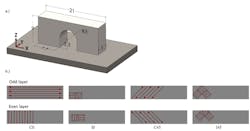Researchers Uncover Problems with 3D Printing and Island Scanning
Laser powder bed fusion (LPBF) is a popular method of 3D printing metal parts. It creates thin layers of patterned metal by scanning a laser over a bed of metal powder in predetermined patterns derived from sectioning a 3D model of the finished product. As the molten metal cools into a solid, a platform supporting the layer(s) lowers and the printer adds a new coat of powder on top, letting the laser continue building the part layer by layer.
Once the second layer is begun, residual stresses start to appear in the metal. That’s because metals used in LPBF cool quickly; by the time the laser heats up a new layer, metal from the previous layer has solidified. The melted layers contract inward as they cool, pulling on the solid metal below and creating stresses. And the greater the temperature differences, the more the melted layers pull. This process repeats for every layer until the part is complete, locking stresses into solid metal.
“You end up with an incredible amount of residual stresses inside your piece,” says Thien Phan, a research engineer at the National Institute of Technology (NIST). “So, the piece is sitting there, tearing itself apart. The residual stress could crack the part and lift it up during the build, which could crash the machine.”
To understand how residual stress forms during 3D printing and how it might be curbed, NIST and several national labs took a closer look at the effects different printing patterns have on 3D-printed titanium alloy parts made according to a standard LPBF method. One pattern they looked at, island scanning, is widely used in industry to decrease residual stress.
The most straightforward printing pattern in LPBF is a continuous scan, where the laser scans back and forth from one end of the layer to the other. An alternative, the aforementioned island scanning, melts small sections (or islands) of metal one at a time rather than an entire layer. This should mean there is less metal contracting at the same time, reducing the overall stress.
The researcher’s data, however, found island scanning created the most stress, defying the team’s expectations.
“This was surprising and underscores the problem’s complexity,” says Phan. “It shows that, although island scanning may work in many cases, it did not work in ours, which really highlights the fact that we need to have accurate modeling.”
For the study, the researchers printed four titanium alloy bridges just over 2 in. long (2 cm). The samples were built with either continuous or island scanning, with lasers running along their length and width or at a 45-deg. angle.
High-energy X-rays generated by a powerful synchrotron were beamed deep into the samples. By measuring the wavelengths of X-rays reflected off the metal, the team could accurately “measure” the distances between metal atoms. From there, the researchers calculated stress. The greater the distances, the more stressed the metal was. With that information, they generated maps showing where stresses were in the sample and how large they were.
All samples had stresses almost equal to the titanium alloy’s yield strength. When stresses do equal a material’s yield strength, it permanently deforms.
“The island-scan samples have really large stresses on their sides and tops, which are missing or much less pronounced in the continuous-scan samples,” says NIST physicist Lyle Levine. “If island scanning is how industry is trying to mitigate these stresses, then for our particular case it was far from successful.”
In another test, the engineers removed a leg of each bridge from the metal base plate it was printed on. The team measured how far the legs sprung upward when related from the plates. This gave them another indicator for how much residual stress was stored inside the bridge. In this test, island scan samples performed poorly, their legs springing up more than twice as far as continuously scanned samples.
Based on their study, the researchers concluded that island scanning could be a double-edged sword. Although small islands may reduce contraction, they might also cool much faster than larger melt pools, increasing temperature differences and thus increasing stress.
Although island scanning might not have been well suited to NIST’s particular part, material and equipment used in the study, it could still be a good choice under the right circumstances, according to the team. The results do, however, indicate it is not a cure-all for residual stress. To minimize stresses, manufacturers may need to tailor the scanning strategy and other parameters to their applications. This could be helped by computer models. And one of the team’s long-term goals is to help manufacturers test and improve predictive models for 3D printing—which, if accurate, could steer them away from destructive levels of residual stress.
Rather than improve 3D printing through trial-and-error, manufacturers could use the models to quickly and inexpensively determine the best parameters.


